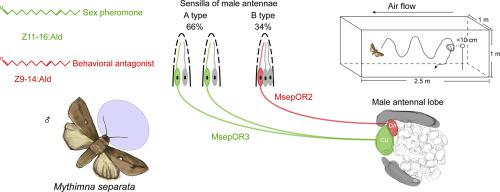Insect Biochemistry and Molecular Biology ( IF 3.2 ) Pub Date : 2020-07-24 , DOI: 10.1016/j.ibmb.2020.103439 Nan-Ji Jiang 1 , Rui Tang 2 , Hao Guo 1 , Chao Ning 2 , Jian-Cheng Li 3 , Han Wu 2 , Ling-Qiao Huang 2 , Chen-Zhu Wang 1

|
Moths often use multi-component pheromones with fixed ratios to keep intraspecific communication and interspecific isolation. Unusually, the Oriental armyworm Mythimna separata in North China use only Z11-16:Ald as the essential component of its sex pheromone to find mates. To understand how this species keeps behavioral isolation from other species sharing Z11-16:Ald as a major pheromone component, we study the olfactory coding of intra- and interspecific pheromonal messages in the males of M. separata. Firstly, we functionally characterized the long trichoid sensilla in male antennae by single sensillum recording. Two types of sensilla were classified: the A type sensilla responded to Z11-16:Ald and Z9-14:Ald, and the B type sensilla mainly to Z9-14:Ald, and also to Z11-16:Ac, Z11-16:OH, and Z9-16:Ald. Next, we examined the glomerulus responses in the antennal lobes to these compounds by using in vivo optical imaging. The results showed that among the three subunits of the macroglomerular complex (MGC), Z11-16:Ald activated the cumulus, Z9-14:Ald activated the dorso-anterior and the cumulus, Z11-16:OH and Z11-16:Ac activated the dorso-anterior and dorso-posterior, respectively. However, Z9-16:Ald activated an ordinary glomerulus. Thirdly, we tested the behavioral responses of the males to these compounds in the wind tunnel. Addition of Z9-14:Ald at the ratio of 1:10 greatly reduced the attractiveness of Z11-16:Ald, addition of Z9-16:Ald or Z11-16:OH at the ratio of 1:1 also had behavioral antagonistic effects, while addition of Z11-16:Ac had no effect on the attractiveness of Z11-16:Ald. Finally, we used antennal transcriptome data and the Xenopus expression system to identify the receptor of Z9-14:Ald in M. separata. The Xenopus oocytes co-expressing MsepOR2 and MsepORco showed a strong response to Z9-14:Ald. Two-color fluorescence in situ hybridization validated that the cells expressing MsepOR2 and MsepOR3, tuned to Z9-14:Ald and Z11-16:Ald respectively, were localized in the different sensilla of male antennae. Comparing the sex pheromone communication channel of the related species, our results suggest that the conserved olfactory pathways for behavioral antagonists play a crucial role in behavioral isolation of noctuid species.











































 京公网安备 11010802027423号
京公网安备 11010802027423号